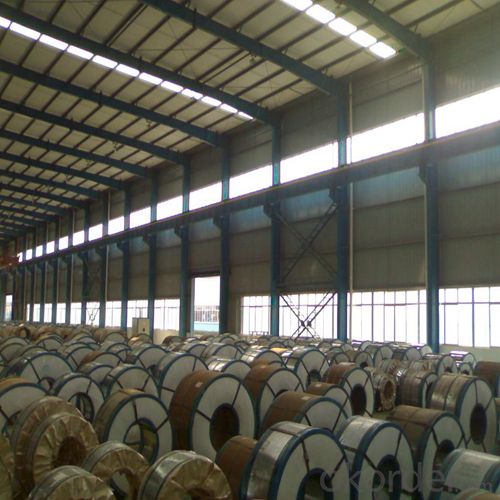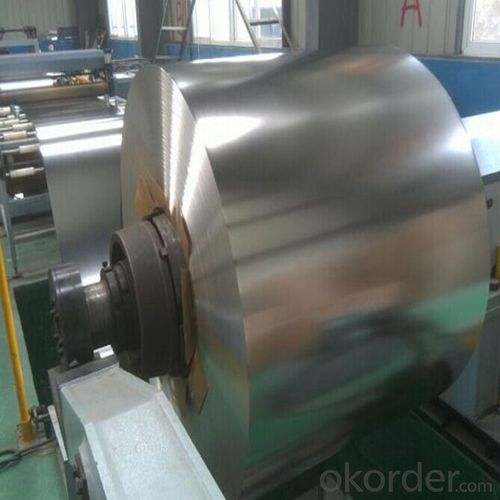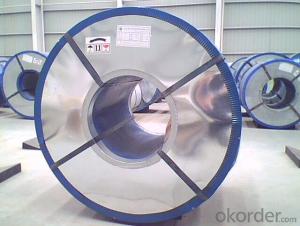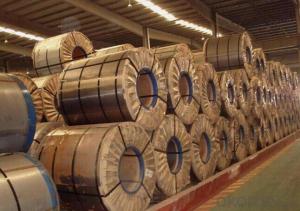Electrolytic Tinplates for Foods Can Packaging
- Loading Port:
- Tianjin
- Payment Terms:
- TT OR LC
- Min Order Qty:
- 25 m.t
- Supply Capability:
- 7000 m.t/month
OKorder Service Pledge
OKorder Financial Service
You Might Also Like
1.Structure of Electrolytic Tin Plate Coils and Sheets for Foods Metal Packaging Description
Electrolytic Tin Plate Coils and Sheets for Foods Metal Packaging, is one thin steel sheet with a coating of tin applied by electrolytic deposition. Tinplate made by this process is essentially a sandwich in which the central core is strip steel. This core is cleaned in a pickling solution and then fed through tanks containing electrolyte, where tin is deposited on both sides. As the strip passes between high-frequency electric induction coils, it is heated so that the tin coating melts and flows to form a lustrous coat.
2.Main Features of the Electrolytic Tin Plate Coils and Sheets for Foods Metal Packaging
Appearance – Electrolytic Tin Plate is characterized by its beautiful metallic luster. Products with various kinds of surface roughness are produced by selecting the surface finish of the substrate steel sheet.
Paintability and printability – Electrolytic Tin Plates have excellent paintability and printability. Printing is beautifully finished using various lacquers and inks.
Formability and strength – Electrolytic Tin Plates have got very good formability and strength. By selecting a proper temper grade, appropriate formability is obtained for different applications as well as the required strength after forming.
Corrosion resistance – Tinplate has got good corrosion resistance. By selecting a proper coating weight, appropriate corrosion resistance is obtained against container contents. Coated items should meet 24 hour 5 % salt spray requirement.
Solderability and weldability – Electrolytic Tin Plates can be joined both by soldering or welding. These properties of tinplate are used for making various types of cans.
Hygienic – Tin coating provides good and non toxic barrier properties to protect food products from impurities, bacteria, moisture, light and odours.
Safe – Tinplate being low weight and high strength makes food cans easy to ship and transport.
Eco friendly – Tinplate offers 100 % recyclability.
Tin is not good for low temperature applications since it changes structure and loses adhesion when exposed to temperatures below – 40 deg C.
3.Electrolytic Tin Plate Coils and Sheets for Foods Metal Packaging Images



4.Electrolytic Tin Plate Coils and Sheets for Foods Metal Packaging Specification
Standard | ISO 11949 -1995, GB/T2520-2000,JIS G3303,ASTM A623, BS EN 10202
|
Material | MR,SPCC |
Thickness | 0.15mm - 0.50mm |
Width | 600mm -1150mm |
Temper | T1-T5 |
Annealing | BA & CA |
Coil Inner Diameter | 508mm |
Weight | 6-10 tons/coil 1~1.7 tons/sheets bundle |
Passivation | 311 |
Oil | DOS |
Surface | Finish,bright,stone,matte,silver |
5.FAQ of Electrolytic Tin Plate Coils and Sheets for Foods Metal Packaging
-What your tinplate material is used for ?
Tinplate is widely used for the packaging of products. Such as food cans,
beverage cans, pet cans, closures, general line cans and so on.
Printed Tinplate is offered!!
-How to place .an order or contact you ?
Please send us Email. we will give you a quick response in seconds .
- How is your quality ?
All our quality is prime even the secondary quality . We have many years experience
In this field with serious quality control standard . Advanced equipment, We welcome your visit to our factory .
- Q:Are there any health concerns associated with tinplate packaging?
- Yes, there are potential health concerns associated with tinplate packaging. Tinplate packaging can sometimes contain small amounts of lead, which is a toxic heavy metal. If the lead leaches into the food or beverage stored in the tinplate packaging, it can pose a health risk, especially in high quantities or with prolonged exposure. Additionally, some tinplate packaging may be lined with a plastic coating that contains harmful chemicals like BPA (bisphenol A) or phthalates, which can also leach into the food or beverage and have adverse health effects. It is important to check the safety of tinplate packaging and ensure it meets regulatory standards to minimize these health concerns.
- Q:How does tinplate compare to other packaging materials?
- Tinplate is highly versatile and durable, making it an excellent choice for packaging materials. It offers superior protection against moisture, oxygen, and light, ensuring the freshness and quality of the packaged products. Additionally, tinplate is eco-friendly as it is 100% recyclable, making it a sustainable choice. Its strength and resistance to corrosion further enhance its appeal compared to other packaging materials.
- Q:How does tinplate packaging contribute to product durability?
- Tinplate packaging contributes to product durability by providing a strong and protective barrier against external factors such as moisture, air, and light. This helps to prevent oxidation, spoilage, and degradation of the product inside, ensuring its quality and extending its shelf life. Tinplate packaging also offers resistance to physical damage, such as dents or punctures, which can further enhance the durability and integrity of the packaged product.
- Q:How does the thickness of tinplate affect its strength and durability?
- The thickness of tinplate directly affects its strength and durability. Thicker tinplate tends to be stronger and more durable, as it can withstand greater external forces and resist deformation. Thicker tinplate also offers better protection against corrosion and can handle harsher environmental conditions. On the other hand, thinner tinplate may be more prone to bending or denting, and it may have reduced durability and resistance to damage.
- Q:How does the coating affect the properties of tinplate?
- The coating on tinplate significantly affects its properties. The coating provides a protective barrier against corrosion, enhancing the tinplate's durability and extending its shelf life. Additionally, the coating can improve the tinplate's resistance to chemical reactions and make it more suitable for food packaging applications. The coating also influences the tinplate's appearance, allowing for various decorative finishes. Overall, the coating plays a crucial role in enhancing the properties and performance of tinplate.
- Q:What are the main differences between tinplate and tinplate laminates in terms of barrier properties?
- Tinplate and tinplate laminates differ in terms of barrier properties primarily due to their composition and structure. Tinplate is a steel sheet coated with a thin layer of tin, which provides excellent corrosion resistance but limited barrier properties against gases and moisture. On the other hand, tinplate laminates consist of a tinplate base combined with additional layers, such as plastic or paper, which significantly enhance the barrier properties. These laminates offer improved resistance against gases, moisture, and light, making them suitable for packaging applications requiring higher protection and preservation of the contents.
- Q:Can tinplate be used for packaging products with sensitive electronic components?
- Yes, tinplate can be used for packaging products with sensitive electronic components. Tinplate is known for its excellent electrical conductivity and corrosion resistance, making it an ideal choice for protecting sensitive electronic components from external factors such as moisture and oxidation. Additionally, tinplate offers good mechanical strength and can be easily formed into various shapes, providing secure packaging for these components.
- Q:How does tinplate perform in terms of tamper resistance?
- Tinplate performs well in terms of tamper resistance due to its strong and durable nature. It is difficult to manipulate or tamper with, providing a secure packaging solution for various products.
- Q:How does tinplate contribute to the presentation of jewelry?
- Tinplate is often used in the packaging of jewelry, such as boxes or containers, which enhances the presentation and adds an element of luxury. Its glossy and reflective surface provides a visually appealing backdrop for showcasing the beauty and intricacy of the jewelry inside. Additionally, tinplate offers excellent protection against corrosion and moisture, ensuring the longevity and preservation of the jewelry.
- Q:How is tinplate coated on both sides?
- Tinplate is coated on both sides through a process called electrolytic tinning. In this process, the tinplate is immersed in an electrolyte solution while an electric current is passed through it. This causes tin ions to be deposited on both sides of the tinplate, resulting in a thin layer of tin coating.
1. Manufacturer Overview |
|
|---|---|
| Location | |
| Year Established | |
| Annual Output Value | |
| Main Markets | |
| Company Certifications | |
2. Manufacturer Certificates |
|
|---|---|
| a) Certification Name | |
| Range | |
| Reference | |
| Validity Period | |
3. Manufacturer Capability |
|
|---|---|
| a)Trade Capacity | |
| Nearest Port | |
| Export Percentage | |
| No.of Employees in Trade Department | |
| Language Spoken: | |
| b)Factory Information | |
| Factory Size: | |
| No. of Production Lines | |
| Contract Manufacturing | |
| Product Price Range | |
Send your message to us
Electrolytic Tinplates for Foods Can Packaging
- Loading Port:
- Tianjin
- Payment Terms:
- TT OR LC
- Min Order Qty:
- 25 m.t
- Supply Capability:
- 7000 m.t/month
OKorder Service Pledge
OKorder Financial Service
Similar products
New products
Hot products
Related keywords





























